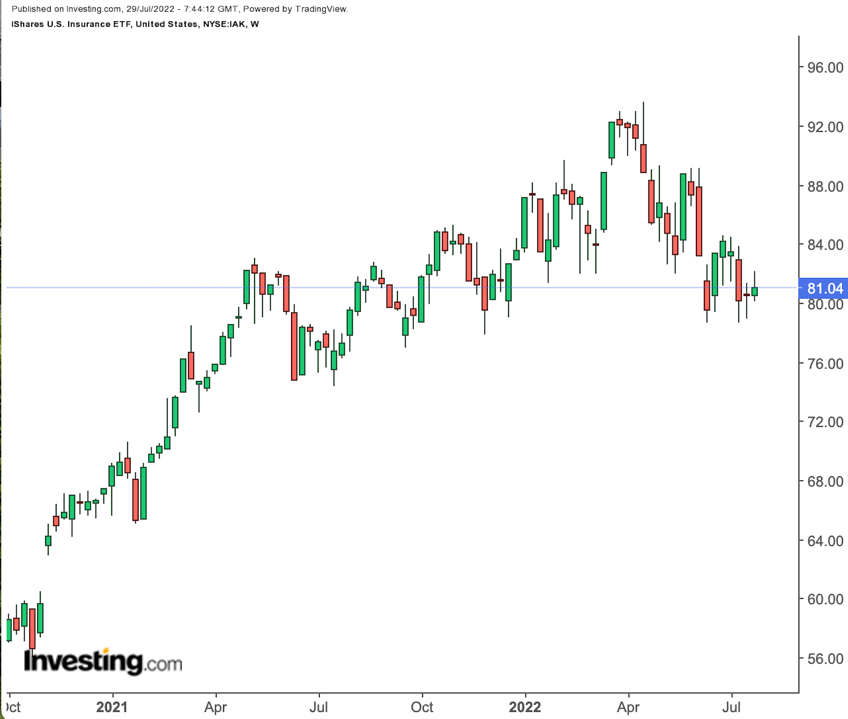- US Federal Reserve increased benchmark interest rate again
- Insurance companies invest in fixed-income securities
- So they typically benefit from rising rates
On July 27, the Federal Reserve (Fed) increased the benchmark interest rate by another 75 basis points in an increased effort to bring US inflation levels down. The FOMC statement released after the meeting highlighted that “the Committee is strongly committed to returning inflation to its 2 percent objective”.
Rising rates typically impact many industries, including the insurance sector. While it is hard to generalize the effects of these rates on an industry as a whole, many insurers benefit when rates increase. Recent research by McKinsey reminds us that the persistently low interest rates in the last decade have meant challenges to growth in the insurance sector.
Most insurers allocate part of the insurance premiums collected in fixed-income securities so they typically benefit from increasing rates. Despite higher costs due to inflation, they can still increase profits.
In 2021, the number of net insurance premiums stateside reached $1.4 trillion. Therefore, it is an essential industry for the economy.
Last year, the global insurance market was roughly $5.38 trillion. Emerging markets will likely continue to provide significant growth for the industry.
1. iShares US Insurance ETF
- Current Price: $81.04
- 52-week range: $76.22 - $93.64
- Dividend yield: 1.95%
- Expense ratio: 0.42% per year
The first ETF we will look at is the iShares US Insurance ETF (NYSE:IAK), which invests in US companies that provide life, property and casualty, and full line insurance. The fund was first launched in May 2006, and net assets stand at $327.8 million.
IAK, which tracks the Dow Jones US Select Insurance Index, has 57 holdings. With regards to sub-sector distribution, we see Property & Casualty Insurance with 54.85%, Life & Health Insurance with 24.45%, Multi-line Insurance with 11.08%, and Insurance Brokers with 7.33%, among others.
Over 60% of the portfolio is in the leading 10 stocks, making IAK a concentrated fund. Among them are Chubb (NYSE:CB), Progressive Corporation (NYSE:PGR), MetLife (NYSE:MET), American International (NYSE:AIG), Travelers Companies (NYSE:TRV), and Arthur J Gallagher & Co (NYSE:AJG).
IAK is currently down around 3% this year but still up over 6% in the past 12 months. We see P/E and P/B ratios of 8.89x and 1.30x, respectively. We believe there could be gains in many of the insurers in the ETF in the months ahead.
2. SPDR S&P Insurance ETF
- Current Price: $37.72
- 52-week range: $35.74 - $42.84
- Dividend yield: 1.94%
- Expense ratio: 0.35% per year
Next up is the SPDR S&P Insurance ETF (NYSE:KIE), an equal-weighted fund that invests in US insurers. It started trading in November 2005.
KIE, which tracks the returns of the S&P Insurance Select Industry Index, has 52 holdings. Property & Casualty Insurance stock has the largest slice, with 44.38%. Next, we have Life & Health Insurance (26.15%), Insurance Brokers (14.68%), Reinsurance (8.78%), and Multi-line Insurance (6.01%).
The top 10 stocks in the portfolio account for roughly a quarter of $518.6 million in net assets. Trupanion (NASDAQ:TRUP), Brown & Brown (NYSE:BRO), Aon (NYSE:AON), Arthur J. Gallagher, Globe Life (NYSE:GL), Kinsale Capital Group (NYSE:KNSL), and Selective Insurance Group (NASDAQ:SIGI) are among the most prominent names in the fund.
KIE has lost around 6.5% of its value since January and is almost flat over the past year. P/E and P/B ratios are at 11.12x and 1.10x. Those readers interested in an equal-weight insurance fund should research KIE further.
Disclaimer: On the date of publication, Tezcan Gecgil, Ph.D., did not have any positions in the securities mentioned in this article.
